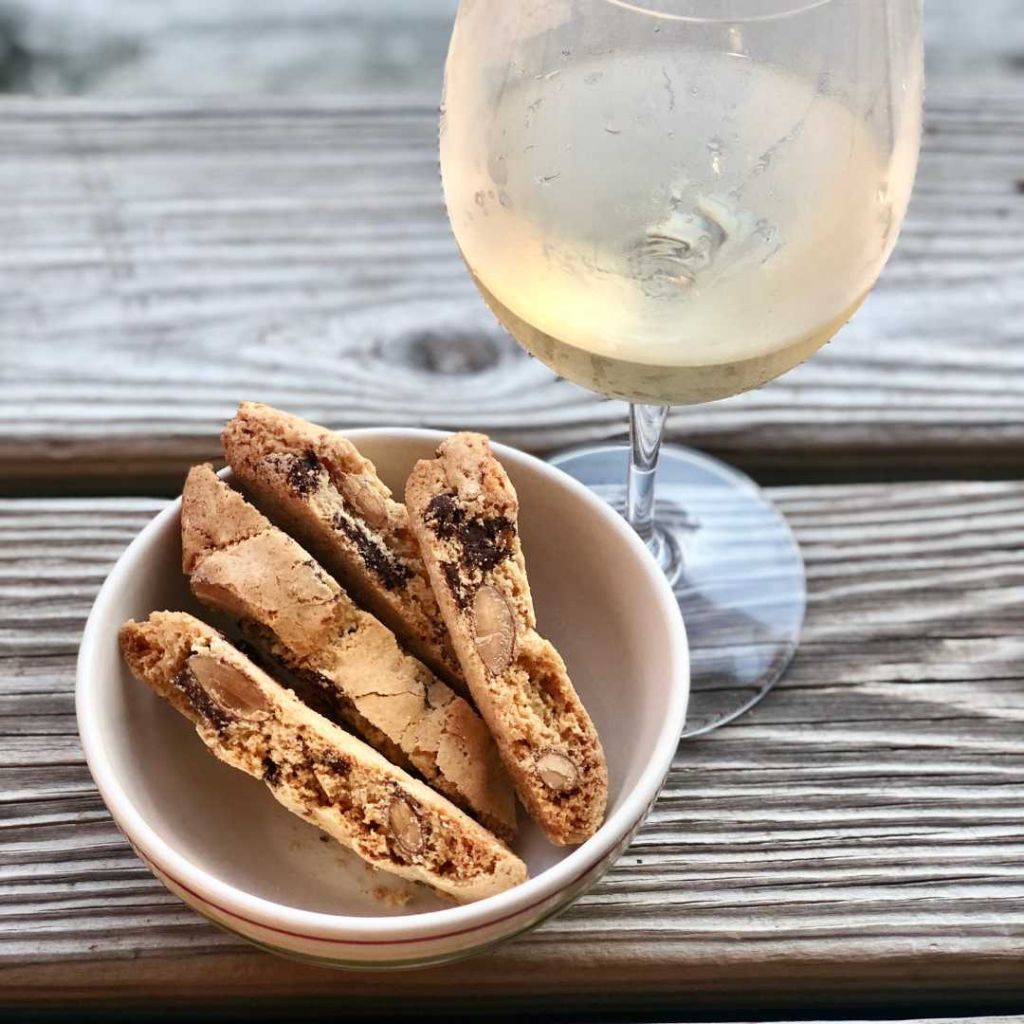Blog
Best Italian Dessert Wines to Pair With Biscotti
Best Italian Dessert Wines To Pair With Biscotti (Vin Santo, Moscato, Marsala)
When people think of an Italian wine dessert, they usually picture tiramisu or panna cotta. In Italy, one of the most timeless endings to a meal is much simpler: a crisp biscotti and a small glass of dessert wine. It is elegant, unfussy, and built on flavor, not frosting.
If you have ever wondered which Italian dessert wines pair best with biscotti – Vin Santo, Moscato d’Asti, Marsala, Recioto, even Icewine – this guide walks you through the classics and a few modern favorites you can enjoy at home.

I have enjoyed Almond Biscotti with Vin Santo many times. After all, I am The Biscotti King. Dessert wines go beyond Tuscany though. Growing up in Toronto, we were a short drive from Niagara-on-the-Lake, known for its Icewine. I remember my first chilled glass on a winter day – rich, golden, sweet, and completely different from anything else. It is not the same as Vin Santo, but it has that same syrupy warmth that makes biscotti feel right at home beside it.
“You do not have to be Italian to enjoy the beauty of slowing down – just a biscotti and a glass of something sweet.”
For a deeper look at history, texture, and how to choose flavors, visit our Biscotti Guide, then come back here to plan dessert wine pairings.
My First Marsala – Palermo, 1982
The first time I tasted Marsala was during our family trip to Italy in 1982. My grandmother owned a small home in Palermo, where my uncle and cousins lived. We spent about a month there that summer: long dinners, kids running through the courtyard, and the scent of espresso drifting through open windows.
Marsala was a staple on the table, always served with biscotti and coffee after dinner. One night, my mother finally let me have a small shot of Marsala mixed with espresso, alongside my biscotto. The sweetness of the wine, the bitterness of the coffee, and the crunch of the biscotti came together in one bite that I still remember today.
What Makes Italian Dessert Wines Special
In Italy, dessert wine – or vino da dessert – is about more than sugar. It is about craftsmanship. Many of these wines are made from late-harvest grapes. Some are dried like raisins before pressing, which concentrates their natural sweetness. The result is a small pour of something golden and complex that you sip slowly.
For Americans, the closest comparison might be a Port or a sweet Riesling, but Italian dessert wines have their own personality. You will find honeyed Vin Santo from Tuscany, floral Moscato d’Asti from Piedmont, nutty Marsala from Sicily, and deep red Recioto della Valpolicella from Veneto. Each one pairs beautifully with different types of biscotti.
Perfect Italian Dessert Wine and Biscotti Pairings
Here are some easy pairings to try at home.
Pick one wine, pick one biscotti, and see how the flavors change with each sip.
Classic Tuscan pairing. Vin Santo brings caramel and toasted almond notes that soften the crunch of a traditional Almond Biscotti.
A lightly sparkling Moscato d’Asti lifts the tart cranberries and whole pistachios in our Cranberry Pistachio Biscotti. Bright and refreshing.
Sicilian Marsala has caramel and dried fruit notes that pull out the cardamom, cinnamon, and clove in our Chai Pistachio Biscotti.
Sweet red Recioto della Valpolicella tastes like dark cherries and cocoa. It loves the black cocoa and Belgian chocolate chunks in our Double Chocolate Biscotti.
Chilled Icewine with a small plate of Biscottini is a fun Canadian and Italian mix. The tiny bites make it easy to taste and share.
If you enjoy licorice notes, try Vin Santo with our Anise Biscotti. The wine’s honey notes sit nicely beside the anise seed.
Shop the pairings:
The Classic: Vin Santo and Almond Biscotti
In Tuscany, biscotti – or cantucci – were made for dipping in Vin Santo. The nutty crunch softens just enough to absorb that caramel and toasted almond flavor. It is a ritual that never gets old.
If you enjoy pairing biscotti with coffee, you might also like our coffee pairing guide. The idea is the same: match the flavor in the cup to the flavor in the cookie.
Modern Pairings for American Tastes
Chocolate Biscotti and Recioto della Valpolicella
If you love chocolate, try a sweet red like Recioto della Valpolicella. It is silky, rich, and tastes like dark cherries and cocoa. It pairs perfectly with our Double Chocolate Biscotti. The fruit in the wine lifts the black cocoa and Belgian chocolate chunks in a way that feels cozy, like dessert by the fireplace.
Cranberry Pistachio and Moscato d’Asti
For something lighter, pair Cranberry Pistachio Biscotti with a chilled Moscato d’Asti. The bubbles lift the sweetness, and the floral aroma makes the cranberries sparkle. It is a bright, refreshing match that works after Sunday brunch or an afternoon on the porch.
Chai Pistachio and Marsala
One of my favorite discoveries came from pairing our Chai Pistachio Biscotti with Sicilian Marsala. The wine’s caramel note pulls out the biscotti’s warm spices – cardamom, cinnamon, clove – in a way that feels both new and familiar. It often wins over people who say they do not like sweet wine.
If you enjoy playing with flavor and want to prep ahead, our guide on how long biscotti stays fresh can help you plan a full tasting night.
Create Your Own Dessert Moment
You do not need to be a sommelier to enjoy biscotti with wine. Grab a few biscotti flavors, two bottles of dessert wine, and small glasses for tasting. Serve the wine slightly cool, not ice cold, so the flavors open up.
Whether it is date night, a holiday meal, or a small dinner with friends, ending with biscotti and dessert wine always feels special. If you are gluten-free, explore our gluten-free biscotti collection for more pairing ideas that fit the way you eat.
Now, when I pour a small glass of wine after dinner, I think back to that summer in Palermo – the laughter, the espresso, the Marsala – proof that the best traditions are the ones you discover when you are young and never let go. So next time you open a bottle, skip the cake. Pour a little dessert wine, grab a biscotti, and see why Italians have ended meals this way for centuries.
Ready to try it yourself? Start with our Almond Biscotti or Cranberry Pistachio Biscotti. Both pair beautifully with your favorite wine.
Frequently Asked Questions
What is an Italian dessert wine?
Italian dessert wines are sweet wines made from late-harvest or dried grapes, such as Vin Santo, Moscato d’Asti, Marsala, and Recioto. They are poured in small glasses and meant to sip slowly with dessert.
Which Italian dessert wine is best with biscotti?
Vin Santo with Almond Biscotti is the classic pairing. Moscato d’Asti works well with fruity biscotti like Cranberry Pistachio, and Marsala pairs nicely with spiced flavors such as Chai Pistachio.
Can you pair biscotti with red wine?
Yes. Sweet reds like Recioto della Valpolicella or a dessert-style Port taste great with chocolate biscotti. The fruit and cocoa notes in the wine balance the chocolate and the crunch.
Do you need to dip biscotti in wine?
No. You can enjoy biscotti on their own. Dipping in wine or coffee softens the texture and brings out new layers of flavor, which is why many people enjoy the dunk.
How long does biscotti stay fresh for dessert pairings?
Our biscotti have a six-month shelf life unopened. Once opened, keep them in an airtight container and enjoy within a week for the best crunch.

